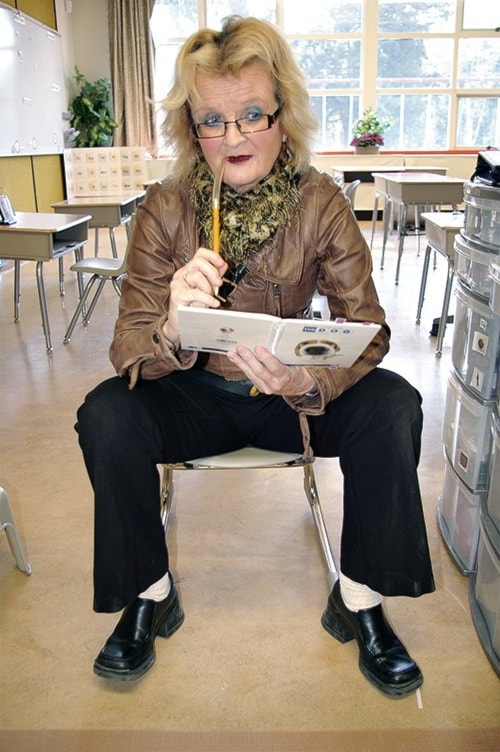There is an order and calmness about Marcy Boudreau’s Grade 1 classroom at Uplands Park Elementary School that seems out of place for a room about to contain 20-odd six-year-olds.
Curtains cover student cubbyholes, the walls are free of the usual riot of colourful posters competing for one’s attention, beige paper covers up walls, binders and filing boxes, and the lighting is soft, coming from a series of lamps rather than the fluorescent tubes overhead.
The students file in and, without prompting from the teacher, hang up their jackets in their cubby holes, drop off their homework in a bin by the back door and head toward their desks.
As they have a quick snack, the students begin working on the morning message up on the overhead projector – this morning, the message reads: “When my engine runs high, I can”, and it is up to students to finish the sentence.
One boy is not ready to sit down and copy out the message; the education assistant has him doing jumping jacks at the back of the classroom. There is another student using a teepee set up behind the desks; a third student uses a standing desk to write; a fourth has a stretchy band and a roller under his desk to keep his feet occupied while he does his work.
After the morning message comes circle time on the carpet in the back corner of the room. Some children sit on stools or little carpets and the teacher goes around handing out items like disposable coffee stir sticks for the children to chew on, squeeze balls and stuffed animals.
Boudreau speaks quietly – she doesn’t need to shout over a hum of talking students like she might have had to in the past – and the morning routine of helping her students determine what they need to do so that they can learn begins.
Each student has a paper car they place in slots on a chart under one of three headings – low, high or just right.
One child who places his car in the ‘low’ spot, explains that his engine is running low because he is feeling tired.
“I still think you’re going to be able to learn because you’re listening,” Boudreau tells him.
One by one, the students discuss why their engines are running too low or too high – tummy pains, an exciting play date after school, a family trip – and what to do to get in that “just right” state to learn – chewing on a stir stick, kneading Silly Putty or sitting in the teepee.
All of the children, including the student in the teepee, are listening and engaging with Boudreau.
In January, Boudreau decided to open up her class and try out this new method of teaching, called self-regulated learning, after visiting a demonstration classroom at Seaview Elementary School in Lantzville.
Self-regulated learning is about teaching students how to learn and acknowledging that each brain is different, each student learns differently, said Brenda Whittam-Neary, a speech and language pathologist Nanaimo school district has contracted with to set up a demonstration classroom and teach educators about the learning method.
“The concept of self-regulated learning is to get children into a calm, alert and focused state so they can manage their behaviour and so they can learn,” she said. “Your end goal is to create independent learners.”
Boudreau admits she was skeptical when she first agreed to pilot the method in her own classroom – when she walked into the demonstration classroom, she questioned Whittam-Neary about funding and why they were simply being shown a demonstration classroom with no children in it.
“For me, I see it, then I believe it,” she said.
Boudreau thought at first that she would be disproving the model, but as they went along, her mind began to change – in the past, Boudreau worked so hard just to get her class to pay attention and by the end of carpet time, she was already stressed out and tired.
“I think I was running higher,” she said. “I felt like I wasn’t doing enough. Now I’m not as tired at the end of the day.”
The effect on her struggling students has been huge – their extra energy is not affecting others like it used to because they are directing that energy at the squeeze balls or stir sticks instead of acting out and they are able to engage in the lessons.
Gone are the days where kids are expected to sit still, hands in their laps, listening to the teacher, added Whittam-Neary.
“The old myth of sitting still to learn is no longer supported in the research,” she said. “There’s a lot of kids who need a lot of movement. When we get kids up and moving is when you get engagement. And you cannot have learning without engagement.”
Boudreau said the most important thing is she didn’t feel judged when Whittam-Neary walked into her classroom – she felt like what was already going on in her classroom was respected.
“I really want people to see this as a supportive opportunity,” she said.
Whittam-Neary said teachers in most schools have been to her demonstration classroom and she has also been out to many schools so educators can learn more about the method.
She is seeking community donations of exercise equipment such as bikes and bosu balls.
To donate, please call the district office at 250-754-5521 or e-mail her at brenda.whittamneary@gmail.com.
Donna Reimer, school district spokeswoman, said some money is available to help teachers obtain equipment for self-regulation. The district received about $20 per student through this supplement this year.
Superintendent Dave Hutchinson said the district’s intent is to encourage teachers to investigate the self-regulated learning approach.
“We hope as more people learn about it, they will be interested in trying out some of the strategies in their classrooms,” he said.
